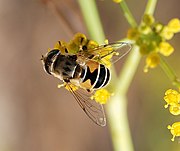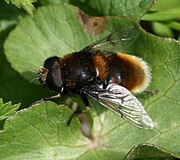Eristalis
| Eristalis | |
|---|---|

| |
| Eristalis tenax on Lantana camara | |
| Scientific classification | |
| Kingdom: | Animalia |
| Phylum: | Arthropoda |
| Class: | Insecta |
| Order: | Diptera |
| Family: | Syrphidae |
| Tribe: | Eristalini |
| Genus: | Eristalis Latreille, 1804 |
| Type species | |
| Musca tenax | |
| Subgenera | |
| |
| Synonyms[1] | |

Eristalis is a large genus of hoverflies, family Syrphidae, in the order Diptera. Several species are known as drone flies (or droneflies) because they bear a resemblance to honeybee drones.
Drone flies and their relatives are fairly common generalist pollinators,[2] the larvae of which are aquatic, and breathe through a long, snorkel-like appendage, hence the common name rat-tailed maggots.[1][3]
Eristalis is a large genus of around 99 species,[4] and is subdivided into several subgenera and species groups (Eristalomyia, Eristalis, Eoseristalis etc.).
Scientific name and grammatical gender[edit]
The scientific name was proposed by Pierre André Latreille in 1804. He placed seven species in his new genus, but listed the names as combinations with Syrphus, so it remained unclear what gender he attributed to the name (the gender of the name Syrphus is masculine). In the two centuries following its publication, Eristalis was sometimes considered to be of feminine gender, sometimes to be of masculine gender. George Henry Verrall (1901)[5] assigned its gender as masculine, a choice followed in British literature, and also in Dutch, Polish, Czech, Spanish and Portuguese literature. In several other European languages and in North America, the tradition was to consider it as a feminine word. In 1993 the International Commission on Zoological Nomenclature placed the name on the Official List, and gave its gender as masculine, without justification for that choice.[6] In 2004, Peter Chandler, Andrew Wakeham-Dawson and Angus McCullough submitted an application to confirm the gender of Eristalis as feminine.[7] They referred to ICZN Art. 30.1.1, which states that a name in Latin form takes the gender given for that word in standard Latin dictionaries.[8] In Composition of Scientific Words by R.W. Brown (1954), "eristalis" is listed as a feminine word that refers to an unknown precious stone. The request of Chandler et al. was granted less than two years after submission.[9] As of 2006, Eristalis is officially a word of feminine gender.
Identification[edit]
For terms see Morphology of Diptera.
As a true fly, Diptera, the species of the genus Eristalis has a single pair of wings and a pair of halteres and as a member of the family syrphidae the presence of a spurious vein in the wing is key. Defined by Latreille in 1804 Eristlis was restricted by Meigen 1882 to those species with a sinuate vein R4+5 and petiolate cell r1. [10]
Since the origin of the genus Eristalis many genera have been added that refine the description of Latreille such as Eristalinus, Meromarcrus, Palpada Helopilus etc. the subtribe Eristalinus has been established to contain these genera. now is generally accepted as which have vein R2+3 sinuate, cell r1 usually petiolate and metafemur with basolateral setose patch. with the addition of the following criteria: Anepimeron with triangular portion bare, Katepimeron pilose Meron bare posteroventrally, without pile anterior or ventral to metathoracic spiracle, eye pilose.
Larvae[edit]
The larvae of Eristalini are aquatic and of the long-tailed type. Those of Eristalis very commonly found breeding in putrid or stagnant water or in moist excrement, and are called “rat-tailed maggots” or “mousies.” [11]
The "tail" is actually an extendable breathing tube often used to extend above the waterline. This tube allows the larvae to live in oxygen depleted water such as sewage and stagnant pools where most other larvae can not exist. Rat tailed larvae also exploit wet mud, manure and moist rotting vegetation. Many species of Eristalis remain unknown.[12] Working in the area where larvae are likely to be found like manure pit, sewage seepage and stagnant pools is difficult and then rearing the larvae to adults is even more so. Basic information on many species of ‘’Eristalis’’ remain to be discovered.
Species[edit]
- Eristalis abusiva Collin, 1931
- Eristalis agrorum (Wiedemann), 1830
- Eristalis alleni Thompson, 1997[3] – Paul Allen's flower fly
- Eristalis alpina (Panzer, 1798)
- Eristalis anthophorina (Fallén, 1817) – orange-spotted drone fly[13]
- Eristalis arbustorum (Linnaeus, 1758) – European drone fly[13]
- Eristalis barda (Say, 1829)
- Eristalis basilaris Macquart, 1834
- Eristalis bellardii Jeannicke, 1867[3]
- Eristalis bogotensis Macquart, 1842[3]
- Eristalis brousii Williston, 1882 – hourglass drone fly[13]
- Eristalis calida Walker, 1849
- Eristalis cerealis Fabricius, 1805
- Eristalis circe Williston, 1891[3]
- Eristalis corymbus Violovitsh, 1975
- Eristalis croceimaculata Jacobs, 1900[3][14]
- Eristalis cryptarum (Fabricius, 1794) – bog-dwelling drone fly[13]
- Eristalis deserta Violovitsh, 1977
- Eristalis dimidiata (Wiedemann, 1830) – black-shouldered drone fly[13]
- Eristalis dubia Macquart, 1834
- Eristalis fenestrata de Meijere, 1908
- Eristalis flavipes Walker, 1849 – orange-legged drone fly[13]
- Eristalis fraterculus (Zetterstedt, 1838) – black-spotted drone fly[13]
- Eristalis gatesi Thompson, 1997[3] – Bill Gates' flower fly
- Eristalis gomonojunovae Violovitsh, 1977 – Arctic drone fly[13]
- Eristalis hirta Loew, 1866 – black-footed drone fly[13]
- Eristalis horticola (De Geer, 1776)
- Eristalis interrupta Poda, 1761) – orange-spined drone fly[13]
- Eristalis intricaria (Linnaeus, 1758)
- Eristalis japonica van der Goot, 1964
- Eristalis jugorum Egger, 1858
- Eristalis kamtshatica Violovitsh, 1977
- Eristalis katoi Shiraki, 1968
- Eristalis kyokoae Kimura, 1986
- Eristalis latifrons Zetterstedt, 1843
- Eristalis lunata de Meijere, 1908, 1776
- Eristalis marfax Curran, 1947
- Eristalis nemorum (Linnaeus, 1758)
- Eristalis obscura (Loew, 1866) – dusty drone fly[13]
- Eristalis oestracea (Linnaeus, 1758) – orange-tailed drone fly[13]
- Eristalis pacifica Violovitsh, 1977
- Eristalis parens Bigot, 1880
- Eristalis pertinax (Scopoli, 1763)
- Eristalis persa Williston, 1891[3]
- Eristalis picea (Fallén, 1817)
- Eristalis precipua Williston, 1888
- Eristalis pseudorupium Kanervo, 1938
- Eristalis rabida Violovitsh, 1977
- Eristalis reflugens Doleschall, 1858
- Eristalis rossica Stackelberg 1958
- Eristalis rupium Fabricius, 1805 – spot-winged drone fly[13]
- Eristalis saphirina Bigot, 1880
- Eristalis saxorum Wiedemann, 1830 – blue-polished drone fly[13]
- Eristalis semicirculus Walker, 1852
- Eristalis similis (Fallén, 1817)
- Eristalis stipator Osten Sacken, 1877[3] – yellow-shouldered drone fly[13]
- Eristalis tammensis Bagatshanova, 1980
- Eristalis tenax (Linnaeus, 1758) – common drone fly[13]
- Eristalis tibetica Violovitsh, 1976
- Eristalis transversa (Wiedemann, 1830) – transverse-banded drone fly[13]
- Eristalis tricolor Bigot, 1880
- Eristalis tundrarum Frey, 1932
- Eristalis vallei (Kanervo, 1934)
- Eristalis vitripennis (Strobl, 1893)
Gallery[edit]
Eristalis abusiva female
Eristalis arbustorum female
Eristalis horticola male
Eristalis nemorum female
Eristalis intricaria male
Eristalis picea male
Eristalis pertinax female
Eristalis tenax male
Eristalis tenax larva
References[edit]
- ^ a b Stubbs, Alan E.; Falk, Steven J (1983). British Hoverflies: An Illustrated Identification Guide (2nd ed.). London: British Entomological and Natural History Society. pp. 253, xvpp. ISBN 1-899935-03-7.
- ^ Van Der Kooi, C. J.; Pen, I.; Staal, M.; Stavenga, D. G.; Elzenga, J. T. M. (2015). "Competition for pollinators and intra-communal spectral dissimilarity of flowers". Plant Biology. 18 (1): 56–62. doi:10.1111/plb.12328. PMID 25754608.
- ^ a b c d e f g h i Thompson, F. Christian (1997). "Revision of the Eristalis flower flies (Diptera: Syrphidae) of the Americas south of the United States" (PDF). Proceedings of the Entomological Society of Washington. Washington D.C.: Entomological Society of Washington. 99: 209–237. ISSN 0013-8797. Retrieved 2009-06-19.
- ^ Thompson, F. Christian (2003). "Austalis, a new genus of flower flies (Diptera: Syrphidae) with revisionary notes on related genera" (pdf Adobe/Acobat). Zootaxa. New Zealand: Magnolia Press. 246: 1–19. doi:10.11646/zootaxa.246.1.1. ISSN 1175-5334. Retrieved 2011-01-28.
- ^ Verrall, G.H. (1901). A list of British Diptera: 22; and, according to Chandler et al., Case 3259 (see there) also in British Flies vol. 8
- ^ ICZN (1993). Opinion 1747. Eristalis Latreille, 1804, Helophilus Fabricius, 1805, Xylota Meigen, 1822 and Eumerus Meigen, 1822 (Insecta; Diptera): conserved. The Bulletin of Zoological Nomenclature 50(3): 256–258
- ^ Chandler, P.J., Wakeham-Dawson, A. & McCullough, A. (2004). Case 3259. Eristalis Latreille, 1804 (Insecta: Diptera): proposed confirmation that the gender is feminine; Musca nemorum Linnaeus, 1758, M. arbustorum Linnaeus, 1758 and M. horticola De Geer, 1776 (currently Eristalis nemorum, E. arbustorum and E. horticola): proposed conservation of usage of the specific names by designation of neotypes. The bulletin of Zoological Nomenclature 61(4): 241–244
- ^ International Code of Zoological Nomenclature Art. 30.1.1
- ^ ICZN (2006). Opinion 2153 (Case 3259). Eristalis Latreille, 1804 (Insecta: Diptera): confirmation that the gender is feminine; Musca nemorum Linnaeus, 1758, M. arbustorum Linnaeus, 1758 and M. horticola De Geer, 1776 (currently Eristalis nemorum, E. arbustorum and E. horticola): usage of the specific names conserved by designation of neotypes. The Bulletin of Zoological Nomenclature 63(2): 146–147
- ^ THOMPSON, F. CHRISTIAN (1997). "Revision Of The Eristalis Flower Flies (Diptera: Syrphidae) Of The Americas South Of The United States". Entomological Society of Washington. 99.
- ^ Wirth, W.W. (1965). Family Syrphidae. In A Catalog of the Diptera of America north of Mexico. Washington, D.C., U.S.A.: United States Department of Agriculture. p. 557-625.
- ^ Rotheray, G.E. (1993). "Colour Guide to Hoverfly Larvae (Diptera, Syrphidae) in Britain and Europe" (PDF). Diperists Digest. Special Edition.
- ^ a b c d e f g h i j k l m n o p q Skevington, Jeffrey H.; Locke, Michelle M.; Young, Andrew D.; Moran, Kevin; Crins, William J.; Marshall, Stephen A. (2019). Field Guide to the Flower Flies of Northeastern North America. Princeton. ISBN 9780691189406.
- ^ Wakeham-Dawson, A.; Jones, A.G.; Thompson, F.C. (2009). "Falkland Islands Syrphidae (Diptera)". Dipterists Digest. Second series. UK: Dipterists Forum. 16 (1): 65–71. ISSN 0953-7260.


_wing_veins.svg/220px-Syrphidae_(Eristalis)_wing_veins.svg.png)
.jpg/220px-Eristalis_sp._(25588804434).jpg)








